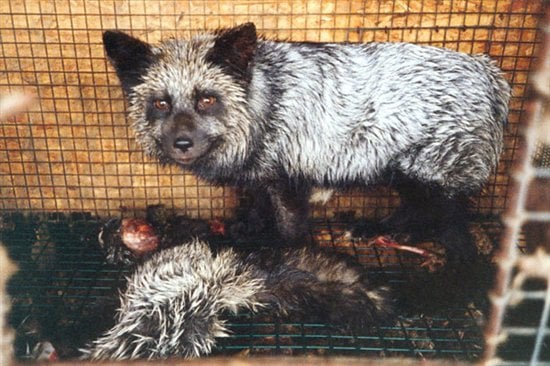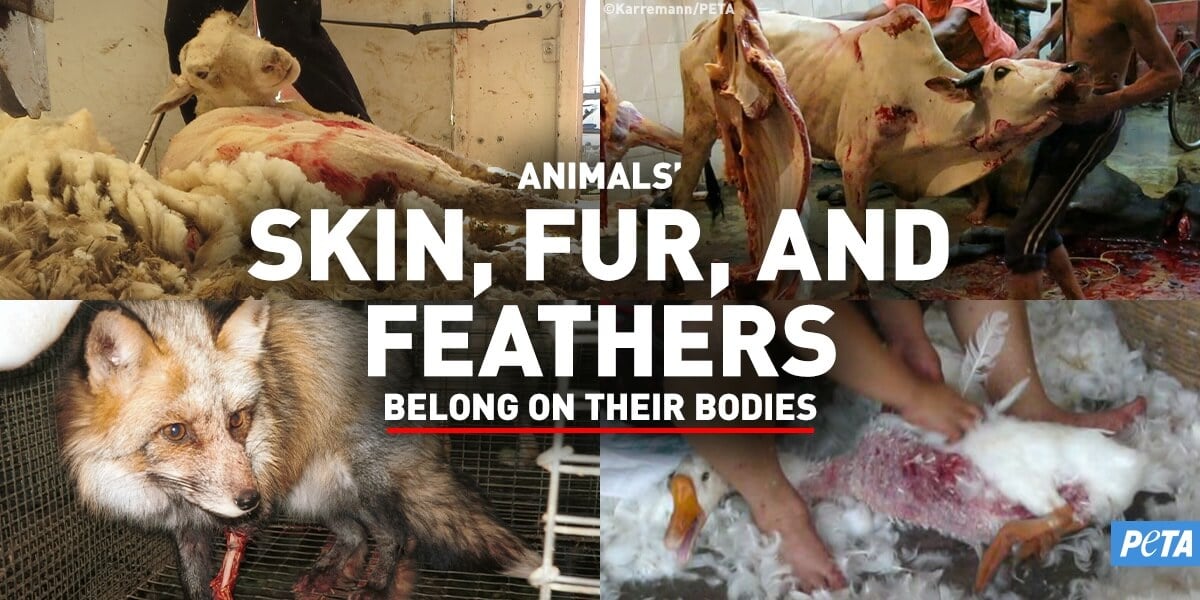Animals Used for Clothing
Every year, billions of animals suffer and die for clothing and accessories. Skin is torn from them to make leather, birds are held down while handfuls of feathers are ripped out of their sensitive skin, and small animals are caged for life before being killed for their fur. Sheep are often beaten and mutilated by workers stealing their wool and their skin for shearling. Goats are similarly abused for cashmere and mohair. All this is done in the name of fashion. No matter the type of material or where it comes from, if the process involves an animal, it involves horrific cruelty.
The practice of wearing animal-derived materials is on its way to becoming a thing of the past, thanks to PETA. Our dedicated activists and supporters have exposed systemic cruelty in the skins (leather), wool, down, cashmere, mohair, and fur trades. Our investigations of these industries have repeatedly exposed widespread and relentless abuse of animals. Our advertisements and demonstrations against these bloody industries are famous for shocking the public, turning heads, and initiating action. We do hands-on work with companies behind the scenes to persuade the largest names in fashion to ditch clothing made from animals. PETA has also led radical actions against top-tier brands, persuading them to stop using animal-derived materials.
This is an exciting time—more so than ever before, people are against wearing animals. From mohair hats to shearling jackets to leather shoes, shoppers are ditching cruel and environmentally toxic items in favor of compassionate and sustainable vegan items.
How Animals Used for Clothing Are Killed
The vast majority of the billions of animals who are killed for their skin, wool, feathers, or fur endure all the horrors of factory farming. Sensitive living beings are forced to live in cramped, filthy conditions, and every bit of freedom and autonomy is taken away from them. Animals suffer at the hands of workers, who may roughly handle, kick, and beat them. After a lifetime of torment, they’re violently slaughtered via the cheapest means possible, including bludgeoning, anal electrocution, and gassing. Some are even dismembered and skinned alive. Trapped animals used for their fur can suffer for days from blood loss, shock, dehydration, frostbite, and gangrene or be attacked by predators before trappers return to kill them.
Fur and leather items are often deliberately mislabeled. In countries where animal welfare laws are virtually non-existent, some producers have been known to kill dogs and cats for fur and leather. So if you wear animals, there’s no easy way of knowing whose skin you’re in. But you can be sure that no matter who they were, they didn’t want to die to become clothing or accessories.
Wearing Vegan Clothing
In addition to causing the suffering and deaths of billions of animals each year, the production of animal-derived materials—including wool, fur, and leather—contributes to climate change, land devastation, pollution, and water contamination.
Advancements in textiles make Earth-friendly vegan materials nearly indistinguishable from and far superior to their animal-derived counterparts. There’s a reason why many outdoor clothing companies have ditched animal fur. The vegan materials available today are much lighter, and they’re far more durable and practical.
Many of us are familiar with common vegan fabrics such as cotton and polyester. But in the 21st century, business in vegan fashion is booming. Clothes and accessories made from hemp, bamboo, and other animal-free materials are now commonplace. They can also be made from innovative and sustainable materials such as cork, mushrooms, pineapple leaves, apple peels, other fruit waste, or recycled plastics. With so many different materials to choose from, there’s no excuse for animals to die violently and painfully for fashion.
The Fur Industry
Whether it came from an animal on a fur farm or one who was trapped in the wild, every fur coat, trinket, and bit of trim caused an animal tremendous suffering—and took away a life. Each year, approximately 100 million animals are killed for their fur.

Animals on fur farms spend their entire lives confined to cramped, filthy wire cages. Fur farmers use the cheapest and cruelest killing methods available, including suffocation, electrocution, gas, and poison.
More than half the fur in the U.S. comes from China, where millions of dogs and cats are bludgeoned, hanged, bled to death, and often skinned alive for their fur. Chinese fur is often deliberately mislabeled, so if you wear any fur, there’s no way of knowing for sure whose skin you’re in.
Animals who are trapped in the wild can suffer for days from blood loss, shock, dehydration, frostbite, gangrene, and attacks by predators. They may be caught in steel-jaw traps that slam down on their legs, often cutting to the bone; Conibear traps, which crush their necks with 90 pounds of pressure per square inch; or water-set traps, which leave beavers, muskrats, and other animals struggling for more than nine agonizing minutes before drowning.
During the annual Canadian seal slaughter, tens of thousands of baby harp seals are shot or repeatedly bludgeoned with clubs tipped with metal hooks. Also in Canada, hundreds of black bears are shot at point-blank range or caught in traps and left to suffer for days so that their skins can be used to make the ceremonial hats worn by Queen Elizabeth II’s Five Guards’ Regiments.
Luckily, there is no need to be cruel to stay warm and look cool. Cruelty-free fabrics and faux furs are available in stores everywhere, and PETA continues to work with designers and clothing retailers to encourage them to use and sell only animal-friendly fabrics.



No comments:
Post a Comment
Thank you for your feedback